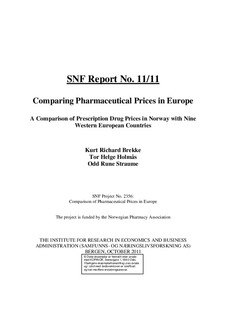| dc.description.abstract | In this report we compare prices of pharmaceuticals between Norway and the following nine Western European countries: Austria, Belgium, Denmark, Finland, Germany, Ireland, the Netherlands, Sweden and United Kingdom. We use product-level sales data from IMS Health, which contain monthly information about prices and sales volumes at wholesale and pharmacy level for all prescription bound sales of 300 substances.
The price comparisons are based on two different approaches. First, we match identical packs and compare pack prices across countries. Second, we match substances and compare volume-weighted average dose prices across countries. The former approach yields a high degree of precision, whereas the latter approach generates a much more representative sample of products, and generates more reliable results.
We compute a large set of price indices using the Norwegian consumption of pharmaceuticals as the benchmark (weights). The overall price indices show that only UK has a lower price level than Norway. The same result is true for the sub-sample of products that are on-patent. These results are likely to be explained by the strict price cap regulation in place in Norway.
In the off-patent market segment, we find that UK and Sweden tend to have lower prices than Norway. Restricting the price comparisons to the products subject to reference pricing (trinnpris) in Norway, the results vary according to how we construct the price indices. If we compare all substances under reference pricing, Norway has the lowest prices. However, if we restrict the comparison to substances with generic competition, then UK, Sweden and Denmark tend to have lower prices than Norway. Finally, computing separate price indices for brand-names and generics in the off-patent market, we find that Norway has the lowest brand-name price level, whereas the generic price level is at the average or higher end of the scale.
Thus, the scope for cost-savings in Norway is limited to importing generic drug prices from UK, Sweden and Denmark. However, the challenge is how to extract the cost-savings, which would crucially depend on the regulatory scheme and the market dynamics. | no_NO |
